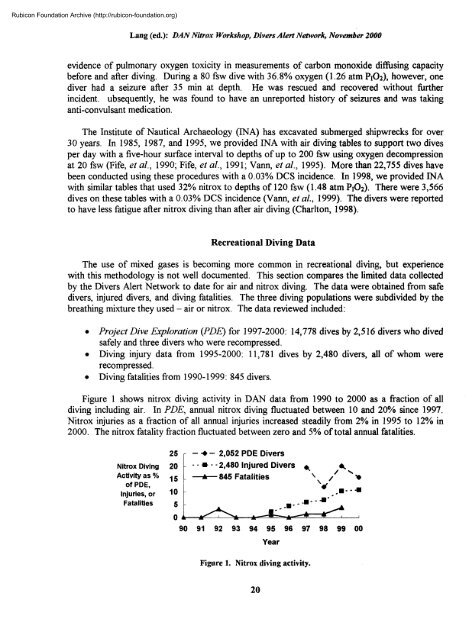Nitrox workshop dings - Divers Alert Network
Nitrox workshop dings - Divers Alert Network
Nitrox workshop dings - Divers Alert Network
Create successful ePaper yourself
Turn your PDF publications into a flip-book with our unique Google optimized e-Paper software.
Rubicon Foundation Archive (http://rubicon-foundation.org)Lang (ed.): DAN <strong>Nitrox</strong> Workshop, <strong>Divers</strong> <strong>Alert</strong> <strong>Network</strong>, November 2000evidence of pulmonary oxygen toxicity in measurements of carbon monoxide diffusing capacitybefore and after diving. During a 80 fsw dive with 36.8% oxygen (1.26 atm P1O2), however, onediver had a seizure after 35 min at depth. He was rescued and recovered without furtherincident, ubsequently, he was found to have an unreported history of seizures and was takinganti-convulsant medication.The Institute of Nautical Archaeology (INA) has excavated submerged shipwrecks for over30 years. In 1985, 1987, and 1995, we provided INA with air diving tables to support two divesper day with a five-hour surface interval to depths of up to 200 fsw using oxygen decompressionat 20 fsw (Fife, et al, 1990; Fife, et al, 1991; Vann, et al, 1995). More than 22,755 dives havebeen conducted using these procedures with a 0.03% DCS incidence. In 1998, we provided INAwith similar tables that used 32% nitrox to depths of 120 fsw (1.48 atm P1O2). There were 3,566dives on these tables with a 0.03% DCS incidence (Vann, et al, 1999). The divers were reportedto have less fatigue after nitrox diving than after air diving (Charlton, 1998).Recreational Diving DataThe use of mixed gases is becoming more common in recreational diving, but experiencewith this methodology is not well documented. This section compares the limited data collectedby the <strong>Divers</strong> <strong>Alert</strong> <strong>Network</strong> to date for air and nitrox diving. The data were obtained from safedivers, injured divers, and diving fatalities. The three diving populations were subdivided by thebreathing mixture they used - air or nitrox. The data reviewed included:• Project Dive Exploration (PDE) for 1997-2000: 14,778 dives by 2,516 divers who divedsafely and three divers who were recompressed.• Diving injury data from 1995-2000: 11,781 dives by 2,480 divers, all of whom wererecompressed.• Diving fatalities from 1990-1999: 845 divers.Figure 1 shows nitrox diving activity in DAN data from 1990 to 2000 as a fraction of alldiving including air. In PDE, annual nitrox diving fluctuated between 10 and 20% since 1997.<strong>Nitrox</strong> injuries as a fraction of all annual injuries increased steadily from 2% in 1995 to 12% in2000. The nitrox fatality fraction fluctuated between zero and 5% of total annual fatalities.<strong>Nitrox</strong> DivingActivity as %of PDE,Injuries, orFatalities252015105r - + - 2,052 PDE <strong>Divers</strong>- - • - - 2,480 Injured <strong>Divers</strong>-—*— 845 Fatalities0 -90 91 92 93 94 95 96P___^ ^ —^^^-Year97 98 99 00Figure 1. <strong>Nitrox</strong> diving activity.20
















